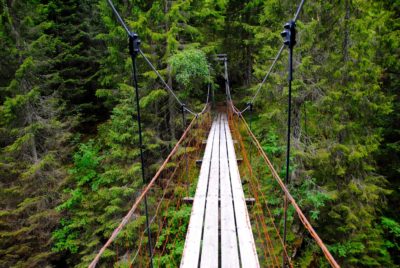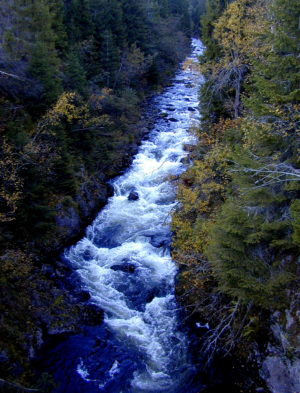A half-forgotten hanging bridge in the hills above Oslo has been saved from demolition following a well-timed social media campaign. Its rescuers won’t be able to use it anytime soon, however, until its owner Statnett can see what shape it’s in.

The spectacular footbridge hangs 13 meters above the roaring rapids of Bjørnsjøhelvete – “Bear Lake Hell.” It’s been compared to the bridge used in a famous scene in the 1984 movie Indiana Jones and the Temple of Doom, minus the sword-wielding baddies closing in on Harrison Ford. There are no hungry crocodiles in the river below, either.

Still, crossing it is not for the faint-hearted. For many a visitor, a peek from the bridgehead is enough.
The unusual bridge was built around 1955 to ease access for maintenance workers to Holsledningen, a major power line supplying Oslo with electricity from Hol in Hallingdalen, almost 200 kilometers north. The bridge appears to have been little used lately, and worse, little maintained.
It has, however, remained a favourite destination for those who like to hike off the beaten track, and it’s been included as a destination twice in Kjentmannsmerket, a cultural orienteering program covering all the forests around Oslo.
The bridge is owned by Statnett, the operator of Norway’s power system. Statnett inherited the bridge through ownership changes following the privatization of Oslo Lysverker, the city utility that once built it. Not needing this kind of infrastructure anymore, Statnett proposed to return it to the City of Oslo a while ago, and also offered it to the national hiking association DNT. When both declined, Statnett decided to tear it down.

The power of Facebook
That’s when Sindre Langaas, an avid hiker and bronze medallist from the 1984 orienteering world cup, decided to try to save the bridge by organizing a Facebook campaign. According to Langaas, the bridge is a “magic” place, and often the destination of his long runs through this part of Oslo’s northern forest known as Nordmarka.
To Langaas’ astonishment, hundreds of people signed up to help save the bridge in a matter of days, and then local media got interested. The Facebook group currently has more than 2,000 members.
“I did get nervous when I saw all the attention the campaign was getting,” Langaas told newspaper Aftenposten. “What if someone fell off the bridge because they had visited as a result of the campaign? I would have felt responsible.”

The start of the campaign happened to coincide with the Corona crisis. Closed gyms and numerous restrictions on organized physical fitness activities have visibly renewed interest in the hills above Oslo, tempting many people to explore quiet trails and remote attractions like the Bjørnsjøhelvete bridge
There’s one problem: nobody knows how solid the bridge really is. According to popular lore quoted by local newspaper Nordre Aker Budstikke, which broke the news about the plans to tear down the bridge in March, it was built to hold one man and a horse. But that was long ago. Langaas doesn’t think any more than two people should be out on the bridge at the same time.
Statnett engineers have stated publicly that they don’t think the bridge is unsafe, but they’re not willing to take any chances. The gate to the bridge was recently locked, and warning signs now dot the area, following a management decision to bow to public pressure and repair the bridge if at all possible. It’s an unfamiliar role for Statnett, which has large electric power projects in Norway’s natural landscapes that often cause controversy, just like the Holsledningen project did in its time.
The massive interest in the bridge appears to have taken Statnett by surprise. Communications chief Henrik Glette told broadcaster TV2 that he’d never even been to the bridge until the social media campaign took off. “It’s a bit amusing that we’re being encouraged to protect some of our own installations,” Glette told TV2.
“We’re more used to the opposite thing happening,” Glette said, taking a couple of reluctant steps onto the bridge for TV2’a cameras.

Historic spot
Lots of industrial history flows between the sombre rock faces of Bjørnsjøhelvete. The river is part of a greater waterway that eventually becomes Oslo’s beloved Akerselva, the river that splits Oslo into its eastern and western regions and is crucial to the capital’s water supply. While the lake Bjørnsjøen to the north is open to skiing in winter and watersports in the summer, drinking water restrictions apply from Skjærsjøen to the south.
In the heyday of Norway’s timber industry, these waters were also used for transportion of logs to the sawmills downriver. The timber floaters, tømmerfløterne as these workers were called, would frequently run into trouble at this particular point, where the rushing water is squeezed through a very narrow vertical gorge. All hell would break loose when heavy logs got stuck here, creating a pile-up which could be difficult and dangerous to sort out. That’s how Bjørnsjøhelvete got its “hellish” name. Another spot in Nordmarka, Myrtjernhelvete, has a similar name for the same reason. It doesn’t have a bridge, but like so many places along this waterway, it does have a historic dam made of stone.

There are other footbridges to be visited as well. One crosses the river Fyllingselven a few kilometers to the north, and was built for similar reasons as the one over Bjørnsjøhelvete. It provided a shortcut for the workers who built the first power masts here in the late 1940s.

Still farther to the north, an even older bridge connects the two banks of the lake Hakkloa. It was constructed in the 1920s to provide children from a local farm with a safe way to school in the shoulder seasons, when it would be dangerous to cross the ice on the lake. During World War II, Norwegian resistance fighters would hide equipment in a hollow part of its eastern bridgehead. These days the bridge is an important connection point for hiking trails in the area.
NewsInEnglish.no/Morten Møst
Video: Crossing “Hell” with Eira the fearless dog (external link to Facebook post)
Video: Temple of Doom rope bridge scene (external link to YouTube clip)

